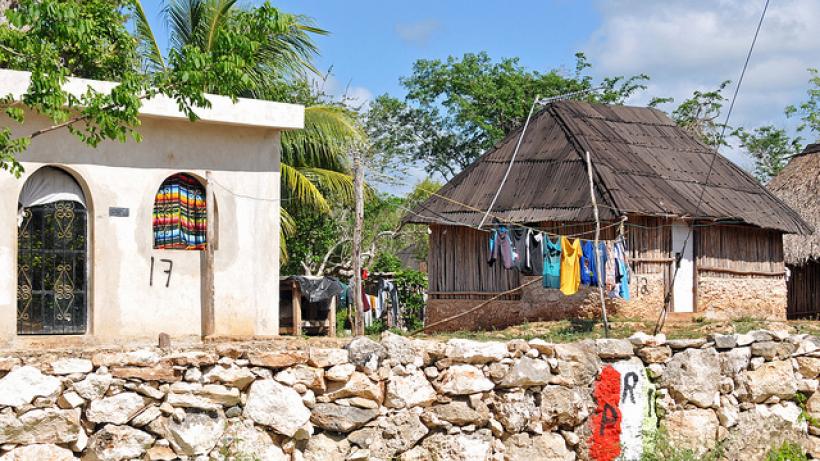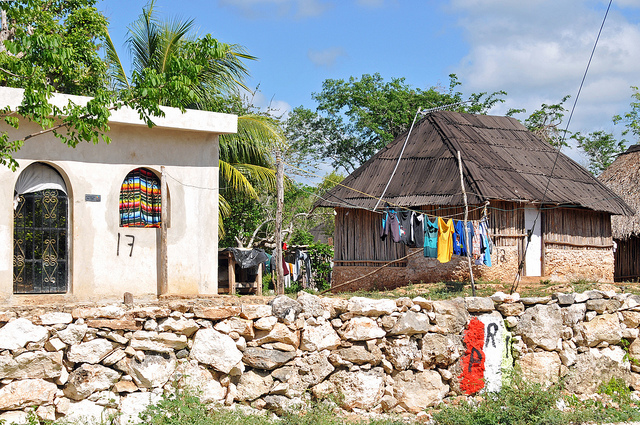
High incidence of violent crime may drive geographic chronic poverty
Exposure to crime disproportionately affects poorer communities. In the case of Mexico, poorer municipalities have fewer resources for comping with the associated risks of high incidence of crime, leaving them trapped in poverty.
Violent crime may directly affect economic activity through a multiplicity of factors, such as deteriorating health conditions, lower school enrollment and graduation rates, diminished labour market participation, and declining economic productivity. Several studies have focused on understanding the average negative effects of crime on economic outcomes. However, it is realistic to believe that crime does not affect all individuals and communities in an economy equally. Inequalities in exposure to violent crime, particularly geographical inequalities, but also inequalities in access to resources, capabilities, markets, and institutions disproportionately affect certain groups and communities, rendering them more vulnerable to the impact of violent crime.

Village of Chendzono
Image credit: Dennis Jarvis
Thus, although one could expect crime to affect all groups and communities in an economy, it might affect those living in poverty disproportionately because the poor usually have fewer resources for coping with the associated risks: they are less able to migrate out of their communities or to pay for private security.
Infrastructure damage from extended conflict contributes to poverty traps
The literature documents the relationship between violent crime and economic activity in the context of civil wars and long-term violent conflict (see Justino 2012 for a comprehensive review of this literature). However, in these contexts, it is difficult to establish convincingly the direction of causality, that is, whether violent crime causes poverty or the other way around. Some may argue that, instead of focusing efforts on this technicality, researchers and, especially, policy makers should aim to reduce both poverty and violent crime. This suggestion seems reasonable in contexts where persistent and intense violence has already influenced economic activity, particularly through diminished infrastructure. Thus, a good first step toward the reduction of poverty is typically investment in infrastructure such as schools, health centers, housing, and roads. Miguel and Roland (2011) highlight this point in relation to Vietnamese regions that suffered bombing attacks during the Vietnam War.
However, previous studies have overlooked a type of violence that does not provoke losses in infrastructure and, ultimately, the relationship between this type of violence and chronic poverty. Although less apparent, this type of violence—such as crime not related to civil wars and conflict—may also affect economic activity and, particularly, socioeconomic mobility, that is, the probability that individuals and communities can move out of poverty.
Higher incidence of crime increases the probability that poorer municipalities remain poor
To fill this gap in the literature, in a recent paper, we look at this issue by studying the case of Mexico in a long-run perspective (1990–2010). This is an interesting case study because, over the last 20 years, local economic development in Mexico has stagnated (Dávalos et al. 2015), and non–drug-related homicide rates have decreased steadily since 1990. These facts make the inverse relationship (that is, poverty to violence) highly unlikely because, during the period of analysis, no large changes in poverty were observed. Our key analysis suggests that crime is an important determinant of the probability a community will remain chronically poor (a community is classified as chronically poor if the percentage of people in poverty remains above the national average during two consecutive periods of five years). In particular, we find that an increase of about 10 homicides per 100,000 inhabitants would double the probability that a municipality will remain chronically poor.
Although, in this study, we do not test for the mechanisms that could explain how an increase in violent crime may boost the probability that communities will remain in poverty, we hypothesize two potential channels that may be at play. On one hand, the potential psychological effect of witnessing violence could translate into higher stress and reductions in good health, which may lower human capital accumulation and utilization through drops in school enrollment and graduation rates and declines in labour market participation. Microeconomic evidence on this causal mechanism has been found in the classroom setting. Carrell and Hoekstra (2010) find that children among classmates who experience domestic violence experience a decrease in reading and math test scores and an increase in misbehavior in the classroom relative to peers whose classmates have not experienced domestic violence. This type of causal mechanism could be considered a behavioral poverty trap such as those that have been put forward in recent studies to explain chronic poverty more effectively than well-established theories have been able to do (see Kraay and McKenzie, 2014).
An alternative and possibly complementary causal mechanism is that violence could cause persistent poverty through its impact on the local economy (Enamorado, Lopez-Calva and Rodriguez-Castelan, 2014). Thus, higher crime rates could affect the probability that a group or community will experience socioeconomic mobility through several factors such as reduced private investment and employment prospects because of uncertainty, the diversion of public resources from poverty reduction strategies to address citizen security, or out-migration among the more well off that could also raise poverty rates (the composition effect).
Policy implications
Regardless of the mechanism that may explain the phenomenon, our results have important implications for public policy because they suggest that policies to enhance citizen security and to mitigate violent crime may be instrumental in reducing persistent poverty. As illustrated by using the non–drug-related homicide rate as a measure of violent crime, even violence that implies no loss in infrastructure has long-run impacts on the incidence of poverty.
References
Carrell, Scott E., and Mark L. Hoekstra. 2010. "Externalities in the Classroom: How Children Exposed to Domestic Violence Affect Everyone's Kids." American Economic Journal: Applied Economics 2 (1): 211–28.
Dávalos, María Eugenia, Gerardo Esquivel, Luis F. López-Calva, and Carlos Rodríguez-Castelán. 2015. “Convergence with Stagnation: Mexico’s Growth at the Municipal Level, 1990–2010.” Sobre México Working Paper 001, Department of Economics, Universidad Iberoamericana, Mexico City.
Enamorado, Ted, Luis F. López-Calva, and Carlos Rodríguez-Castelán. 2014. "Crime and growth convergence: Evidence from Mexico." Economics Letters 125 (1): 9-13.
Justino, Patricia. 2012. “War and Poverty.” IDS Working Paper 391 (April), Institute of Development Studies, Brighton, United Kingdom. http://www.ids.ac.uk/files/dmfile/Wp391.pdf.
Kraay, Aart, and David McKenzie. 2014. “Do Poverty Traps Exist? Assessing the Evidence.” Journal of Economic Perspectives 28 (3): 127–48.
Miguel, Edward, and Gérard Roland. 2011. “The Long-Run Impact of Bombing Vietnam.” Journal of Development Economics 96 (1): 1–15.

